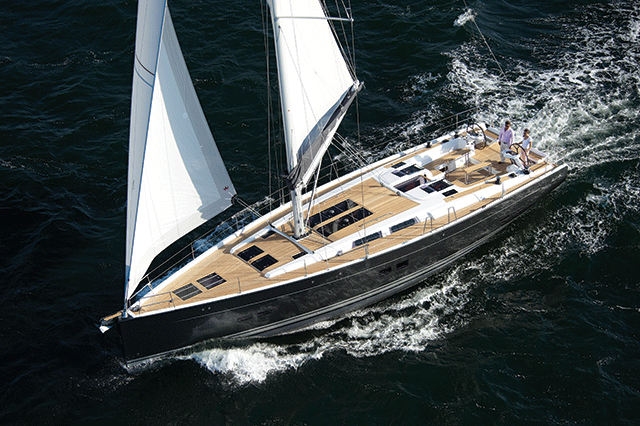The German builder has designed and built one of the most modern cruising boats on the planet that still has a traditional feel By George Day
The new Hanse 575 debuted in America at the Newport International Boat Show last September in Newport, R.I. During the four days of the show, I walked by the boat, visited the Hanse display several times and even had a thorough tour of the new boat. But, I still couldn’t get over just how big it appeared from the floating docks. And, standing at the aft end of the cockpit and looking forward, you would swear you were aboard a 70 footer.
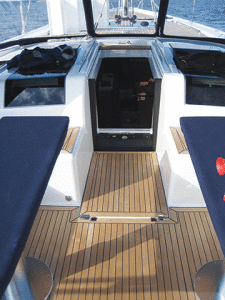 Designed by Judel/Vrolijk & Co, the 575 breaks new design ground for Hanse in several interesting ways. The boat’s topsides are as high off the water as any boat in the size range with square, tinted hull ports that both admit a lot of light to the interior and break up the expansiveness of the hull. The bow and stern are nearly plumb and the cabin top lies very low to the side decks; there is plenty of headroom inside due to the high topside.
Designed by Judel/Vrolijk & Co, the 575 breaks new design ground for Hanse in several interesting ways. The boat’s topsides are as high off the water as any boat in the size range with square, tinted hull ports that both admit a lot of light to the interior and break up the expansiveness of the hull. The bow and stern are nearly plumb and the cabin top lies very low to the side decks; there is plenty of headroom inside due to the high topside.
The bow has a small sprit that doubles as an anchor roller and a teak step for those times when you are Med-moored with the bow to the quay. The 575’s stern folds down to create a huge platform and in the process exposes the dinghy garage that is neatly tucked under the cockpit. The garage was designed specifically for a Williams jet drive RIB but other RIBs can fit inside as well.
The boat has a lot of beam, which adds to the interior volume and increases the hull’s initial stability. Like most modern Euro-designed cruisers, the 575 is intended to be sailed very flat. Interestingly, Hanse and Judel/Vrolijk decided to eschew the chines that have appeared recently in several popular brands so the hull has no hard edges.
The look of the 575 is distinctive, powerful and voluminous. The decks are spacious and flat, the cockpit huge and the sightlines forward from anywhere aboard are wide open. I was somewhat amazed by the boat at first and couldn’t wait to go sailing.
SIMPLE SAILING
Our test sail on Rhode Island’s Narragansett Bay was to involve delivering the 575 five miles from the docks at the Newport Yachting Center to New England Boatworks in Portsmouth, R.I., where it would be based. We backed the big 57 footer out of her slip and while still in reverse, dodged a few passing boats before we could swing the bow around and head toward open water. The 575 handled beautifully under power. The high aspect, semi-balanced spade rudder is large enough to really grab the water and swing the boat around. The feel through the mechanical steering system was positive and precise.
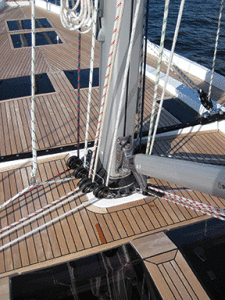 We put the Volvo 110-hp. diesel through its paces as we motored out into the bay. At cruising revs of 2200 rpms, the 575 maintained an easy 7.5 knots and did so very quietly. The engine room is well insulated so at that speed you barely hear the engine and feel no vibration underfoot. At maximum revs, the 575 plowed along at nearly 9 knots on the flat water inside the bay. The 575 carries 138 gallons of diesel. At a conservative 1800 rpms, the engine will burn about a gallon an hour and generate 6.5 knots of boat speed. That translates into an 845-mile cruising range, which is a good safety margin when passagemaking.
We put the Volvo 110-hp. diesel through its paces as we motored out into the bay. At cruising revs of 2200 rpms, the 575 maintained an easy 7.5 knots and did so very quietly. The engine room is well insulated so at that speed you barely hear the engine and feel no vibration underfoot. At maximum revs, the 575 plowed along at nearly 9 knots on the flat water inside the bay. The 575 carries 138 gallons of diesel. At a conservative 1800 rpms, the engine will burn about a gallon an hour and generate 6.5 knots of boat speed. That translates into an 845-mile cruising range, which is a good safety margin when passagemaking.
The 575 comes with a traditional mainsail with lazy jacks and a stack pack. With the bow held carefully head to wind, we hoisted the big sail and trimmed for upwind sailing. Under main alone, the boat sailed fine and could be tacked without trouble. After a couple of tacks we rolled out the 100-percent, self tacking jib and proceeded to tack seaward for a few of miles. The 575, like her sisterships, is quite close winded for a cruising boat. In the 10 knots of sea breeze, we sailed at 35 degrees to the apparent wind and tacked inside 85 degrees. The boat has a cruising fin keel with a T-bulb. As you accelerate after tacking, you can feel the keel develop lift and urge the hull to windward. Upwind, the helm was balanced and the feel was very precise.
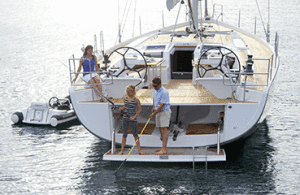 To get to our destination we had to fall off and jibe our way up the bay. We could have used more wind or a cruising chute at this angle since we had the tide against us and were making only about five knots through the water. To keep the jib functioning downwind you need to sail at about 160 degrees to the apparent wind. Or, you can opt to sail wing and wing, but to do so you need to rig the jib sheet to the toe rail instead of the self-tacking sheet car. That way, you can open the sail and tighten the leech. We did this and found that the 575 trundled along nicely and was very easy to handle. The rig is set up so you can mount a rolling Code Zero or a flat asymmetrical chute on a top-down-furler whenever you go out sailing. That way, when you fall off on a reach or run, you will have plenty of sail area for fast, fun sailing.
To get to our destination we had to fall off and jibe our way up the bay. We could have used more wind or a cruising chute at this angle since we had the tide against us and were making only about five knots through the water. To keep the jib functioning downwind you need to sail at about 160 degrees to the apparent wind. Or, you can opt to sail wing and wing, but to do so you need to rig the jib sheet to the toe rail instead of the self-tacking sheet car. That way, you can open the sail and tighten the leech. We did this and found that the 575 trundled along nicely and was very easy to handle. The rig is set up so you can mount a rolling Code Zero or a flat asymmetrical chute on a top-down-furler whenever you go out sailing. That way, when you fall off on a reach or run, you will have plenty of sail area for fast, fun sailing.
We didn’t have a chance to sail the boat in a breeze over 10 knots, but in light airs she handled well and offered a good turn of speed. We have sailed the 575’s sistership, the 495, in 25 knots of rising breeze off Marblehead, Massachusetts, and can report that a very similar hull shape, keel and rudder configuration, and rig handled the blow with real power and style. I fully expect the 575 to be even stiffer and more stable in windy and bouncy conditions.
LIVING ABOARD
The Hanse line has always embraced modern Euro-styling in the layout and design of the boats’ interiors. But that characterization can be a little misleading since the detailing of the joinery and the finish evokes generations of yacht style and tradition.
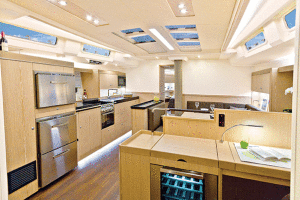 The boat we sailed had the three-cabin, three-head layout. The master cabin lies forward and offers a centerline double berth that has plenty of space around so it is easy to make up the bed and to climb in and out of it without disturbing your mate. The head and shower have their own compartments to port and starboard. There is plenty of locker and hanging space forward for carrying all the clothing you will need for living aboard and sailing through different seasons and climates. The large windows on both sides of the hull are positioned so you can lie in bed and watch the world go by.
The boat we sailed had the three-cabin, three-head layout. The master cabin lies forward and offers a centerline double berth that has plenty of space around so it is easy to make up the bed and to climb in and out of it without disturbing your mate. The head and shower have their own compartments to port and starboard. There is plenty of locker and hanging space forward for carrying all the clothing you will need for living aboard and sailing through different seasons and climates. The large windows on both sides of the hull are positioned so you can lie in bed and watch the world go by.
The saloon has the galley to port and the big dinette to starboard. The galley runs the full length of the saloon and has a large fridge and freezer and room for a dishwasher. The wine cooler is tucked into the furniture aft next to the chart table.
This galley is spacious and has plenty of storage lockers. Underway, it will be convenient to use on starboard tack. And while on the port tack you will find a brace for your hips amidships. Because the 575 needs to be sailed quite flat to maintain speed and comfort, the inline galley works fine. The dinette is huge and will seat eight for dinner. When you want to lounge around and watch a movie, the table can be lowered and covered with cushions to make a lounging area.
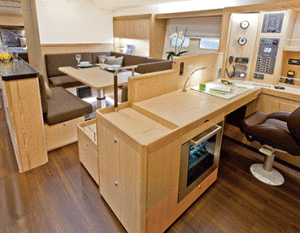 The chart table and system control center is aft to starboard. This will make a good office for navigation, work and communications. There is plenty of space for installing computers, sat phones, radios and navigation electronics.
The chart table and system control center is aft to starboard. This will make a good office for navigation, work and communications. There is plenty of space for installing computers, sat phones, radios and navigation electronics.
Aft, the boat we sailed had twin quarter cabins each with its own head and shower. Because of the boat’s high topsides and large hull volume, these cabins are remarkably spacious and bright. You don’t feel as though you are climbing into a cave; instead, you are stepping into a very pleasant ship’s cabin with plenty of light and ventilation.
The boat has a number of different interior layout options. Forward, you can replace the master cabin with two side-by-side double cabins, each with a small head. Aft you can opt for a small cabin with upper and lower berths in place of the port aft head. And, for those who want to sail with crew, you can convert the huge sail locker in the forepeak to a single cabin with its own head that is accessed through the big deck hatch.
The fit and finish of the Hanse line and the 575 is modern and stylish. At boat shows, you often hear people seeing the boat for the first time stop and say “Wow” when they climb down the companionway ladder. They are amazed at the amount of space and the warm, bright look of the furniture.
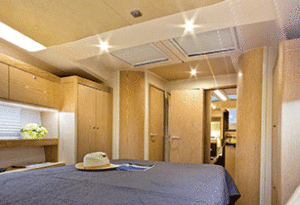 This is a boat that a family of four could live aboard and cruise in style and comfort. It is roomy, well thought out and has the fuel and water capacity and engineering systems for the long haul. For winters in Mexico or the Caribbean and the passages back and forth, the 575 has what it takes and will compare very favorably to the other cruising boats in the mid-50 foot range that are on the market. And, because the boat is easy to handle under sail and power, a couple will find that they can sail on their own without need for crew.
This is a boat that a family of four could live aboard and cruise in style and comfort. It is roomy, well thought out and has the fuel and water capacity and engineering systems for the long haul. For winters in Mexico or the Caribbean and the passages back and forth, the 575 has what it takes and will compare very favorably to the other cruising boats in the mid-50 foot range that are on the market. And, because the boat is easy to handle under sail and power, a couple will find that they can sail on their own without need for crew.
Hanse 575
LOA 56’3”
LWL 49’8”
Beam 17’0”
Draft (stnd.) 9’4”
Draft (option) 7’4”
Displ. 42,990 lbs.
Ballast 13,007 lbs.
Sail area 1,637 sq. ft.
Water 214 gals.
Fuel 138 gals.
Engine 110-hp. Volvo
Mast height 83’0”
Designer Judel/Vrolijk
Douglas Brophy
Hanse, North and South America
44 Merrimac St.
Newburyport MA. 01950
978-239-6568
Skype Broph12
www.hanseyachts.com















